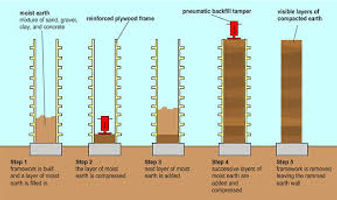A little history about a whole lot of history
The earliest examples of rammed earth are lost to the ages; however, evidence of advanced technique dates back at least seven thousand years to provinces along the Yangtze River in China, where by 2000 BC it was in common use. Variations of the process have been used on every continent except Antarctica. Called hangtu in Chinese, taipa, tapia, and pise in Portugal, Spain, and France respectively, rammed earth or rammed chalk in the English-speaking world, and by many different names across Africa and the Middle East.


In North America, its use in sophisticated structure dates to at least the early 1800s, with numerous residences, churches and agricultural buildings still seeing daily use now into their third century. The introduction of stabilizers, in particular Portland cement, was pioneered in the 1940s by Architect George Middleton of Sydney, Australia, and by the mid-seventies was widely adapted and in use from the South Pacific to North America to continental Europe, where architects, engineers and builders have begun to revolutionize the process with an eye toward expanding its utility and reach.
The basics
For all the many advances in rammed earth technology, it remains at its core a very simple process. Temporary hollow formwork is erected at the planned wall location and a single thin layer of the selected earthen mix is placed at the bottom of the form, compacted either manually or mechanically to approximately 60% percent of its original volume, and the process is then repeated until the desired wall height is achieved. At that point the formwork is removed and the wall is complete. The evolution in technique since those early days in

China has not changed the basic process. Advances in form-work and blending methods, mechanical compaction, soil selection and mix design have improved the practice. As have better foundations, bond beams, and other structural advances, not to mention an evolved understanding of the science and engineering requirements for complying with modern building codes.
It all starts with the earth
The use of un-altered, site-sourced soil for rammed earth construction goes back as far as earthen construction itself. Even today in many developing countries it remains the most viable option. In North America, site soil is still commonly used for adobe, compressed earth block, and other "unit masonry" or modular structures. Its use in rammed earth, however, is becoming increasingly rare. The monolithic nature of the finished wall, as well as the general tendency to leave rammed earth un-rendered, makes it less forgiving. Most often some level of processing will be required to attain standards required for use in modern walls. Different sourcing options will inevitably present different challenges and advantages, so a thorough approach to locating the best source is one of the most important components of any project. The characteristics of a soil blend that matter most are straightforward -- particle size distribution and clay content being the most critical but not the only important elements. Simple field assessments have for centuries been the standard for determining suitability, and many structures which relied upon them remain intact, robust, and in use. What we can't know is the number of structures that relied upon them which have returned to ground, nor the reasons for their failure. This is one riddle behind ECI's efforts to research and standardize the soil selection process as well as the development of science based codes and best practice standards.

The D word (design matters)

Aesthetics aside, any structure, no matter what its made of, will be more successful and resilient if its design and the materials used are well aligned, both with each other and with the environment in which it is built. Wide diurnal swings of temperature are common in the dry desert southwest of the United states. These temperature swings power the famous "thermal flywheel" effect, using the sheer mass of earthen walls to more efficiently achieve a level of interior comfort. In flood prone central Texas, where long hot summer days melting into warm summer nights is common, a wide roof to throw some shade can temper the heat and fend off the rains. Different soils require different approaches to bear the immense weight of earthen structures and in places where the ground is prone to shaking, earth, like all materials, requires some additional attention. These are a few of the many reasons to dig deep into the process before putting earth into forms. Beautiful pictures in glossy magazines can be hypnotizing. The keys to a truly remarkable structure lie a little deeper beneath the surface.
Tools of the trade
A few wooden planks, posts, and willing hands for digging, plus a heavy timber for tamping and most people could, given time, ram an earthen structure of sorts. Make the planks straight, dig the posts deep and tie them at the top, find good shovels and several strong bodies, and that structure could be a home. Choose a good soil, add a solid foundation plus the right sort of roof, and the great grandchildren of those strong bodies might just be sitting around a fire in that same home contemplating an addition for the baby. Like all building technologies, rammed earth's success is largely dependent on the tools available to the builder. Unlike some technologies, not many tools are required.


In industrialized societies today, rammed earth structures are for the most part built using equipment adapted from other construction disciplines. Common forming systems are borrowed from the concrete industry or are riffs on ancient techniques using material familiar to any good house framer. Shovels have yielded to backhoes and excavators; high powered compressors and pneumatic tampers have replaced the heavy timber. Throw in some skid steers, tillers or volumetric mixers for soil blending, and electric conveyors for placing the earth, and you can turn that home into a castle. The fact is, any number of approaches can work depending on the budget, schedule and aspirations of the builder. One thing hasn't changed though: rammed earth remains a labor-intensive endeavor, so don't forget those strong bodies.
Watch this space
ECI is working hard to expand the information we offer.
This page is currently under construction. Please check back soon
Coming soon...new developments in rammed earth,
project features from across the globe,
and an expanded technical section.



